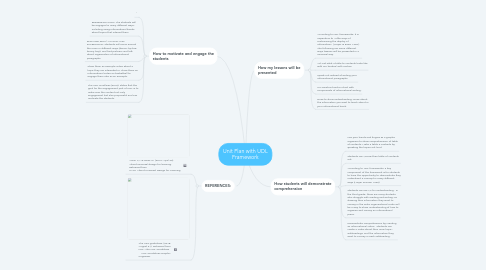Unit Plan with UDL Framework
by Caroline Kiddie

1. How to motivate and engage the students
1.1. `
1.2. REPRESENTATION: The students will be engaged in many different ways- including using informational books about topics that interest them
1.3. ENGAGEMENT/ ACTION AND EXPRESSION: Students will move around the room in different ways (dance, tip-toe, bunny hop), and find partners and talk about organization of informational paragraphs.
1.4. Show them an example video about a topic they are interested in- show them an informational video on basketball to engage them also as an example.
1.5. The UDL Guidlines (2018), states that the goal for the engagement part of UDL is to make sure the content not only engagement but also purposeful and can motivate the students.
2. REFERENCES:
2.1. Anne, M., & Rose, D. (2019, April 23). About universal design for learning. Retrieved from CAST: About Universal Design for Learning
2.2. The UDL guidelines. (2018, August 31). Retrieved from UDL: The UDL Guidelines UDL Guidelines Graphic Organizer
3. How my lessons will be presented
3.1. According to UDL frameworks, it is imperative to "offer ways of customizing the display of information" (Meyer & Rose, 1990). The following are some different ways lessons will be presented in a universal way.
3.2. Act out what a table to contents looks like with our bodies/ with motion
3.3. Speak out instead of writing your informational paragraphs.
3.4. Co-construct anchor chart with components of informational writing.
3.5. Draw to show understanding- Draw about the information you want to teach about in your informational book.
4. How students will demonstrate comprehension
4.1. Use your hands and fingers as a graphic organizer to show comprehension of table of contents- Make a table a contents by speaking the topics out loud
4.2. Students can WRITE their table of contents out.
4.3. According to UDL frameworks, a key component of the framework is for students to have the opportunity to demonstrate they understand a concept in many different ways (Meyer & Rose, 1990).
4.4. Students can DRAW for understanding. In the third grade, there are many students who struggle with reading and writing, so drawing their information they want to convey in the write organizational order will be a way to show understanding of how to organize and convey an informational piece.
4.5. Demonstrate comprehension by creating an informational video. Students can create a video about their main topic, subheadings, and the information they want to convey in each subheading.


